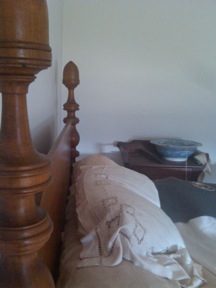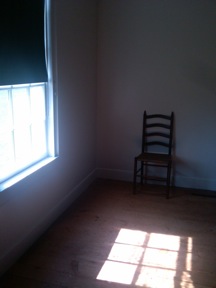The Sound of History at the Stonewall Jackson Shrine
 “What do you like best about working here at the Shrine?” a colleague asks.
“What do you like best about working here at the Shrine?” a colleague asks.
I’m gazing through wavy panes of imperfect glass out toward the parking lot, looking for signs of visitors on this Saturday morning. It’s nearly eleven, and so far only five people have stopped to visit the Stonewall Jackson Shrine. It’ll pick up—it always does on the weekends—but sometimes, there’s not much to do but read or make conversation.
Or listen.
From the room where Jackson died, a clock ticks. “When you step into the room,” I tell visitors, “you’ll hear the same sound that Jackson heard from the same clock as it ticked away the last few days of his life.”
We all have a variation of that line: the clock, the blanket at the foot of the bed, and the bed itself are all original artifacts tied to Jackson’s death. The ticking of the clock gives visitors a sublime way to personally connect to that story.
The clock is an Ingraham clock from Waterbury, Connecticut. “Oh yes—an Ingraham,” a visitor once told me. “Those were really something. I’m not surprised it’s still ticking. Those Ingrahams were built to last.”
Mary Chandler brought the clock from the plantation’s main house out to the office building because she thought the office too quiet. Indeed, even today, the ticking sounds a little hollow as it fills the sparse rooms of the wooden building. The sound doesn’t echo so much as it pulsates, a clockwork heartbeat that makes solitude its own.
Somehow, the tock-ticks that mark the passage of time also capture it. Visitors tell us that stepping into the Stonewall Jackson Shrine is like stepping back in time.
The new fire-suppression system that pokes from the ceiling, the lamp that sits on the historian’s desk, the cool-conditioned air that flows through the rooms—they’re all reminders of modernity. But visitors willfully suspend belief in exchange for the building’s overall feel of history. “It even smells like history in here,” my daughter once said.
The thunk of cowboy boots on pine floors conjures the presence of staff officers moving in and out of the building as Jackson convalesced in the room at the foot of the stairs. The signs of their occupancy fill one of the other downstairs rooms: a clay pipe, a folded newspaper, a tin cup. A sword still in its scabbard sits across the arms of a chair in front of a bookcase.
 On quiet afternoons, late in the day, I can sit on the staircase just outside Jackson’s room and watch the sunlight spill through the west-facing window in the entrance hall. It makes bright rectangles on the floor, the imperfections of the glass showing up as vague shadowy waves. The sunlight slides across the floor, smooth, inexorable. I can almost hear the whisper of it happening.
On quiet afternoons, late in the day, I can sit on the staircase just outside Jackson’s room and watch the sunlight spill through the west-facing window in the entrance hall. It makes bright rectangles on the floor, the imperfections of the glass showing up as vague shadowy waves. The sunlight slides across the floor, smooth, inexorable. I can almost hear the whisper of it happening.
So what do I like best about working at the Shrine?
I smile at my colleague, turn my head just a bit, and hold my hand to my ear. Together, my colleague and I listen.
In the quietude, we can hear history.
Wonderful post is all I can say! You have captured perfectly what it is like to feel history. Who said time travel is not possible? Hope to get down to the Shrine one of these days to experience it for myself.
Ron
Thanks, Ron. I hope you get the chance to visit the Shrine–sooner rather than later. It’s a place of incredible sublime power.
What evocative writing. I loved every word, every image. Jackson Shrine is a very special, if not frequently visited, place.
Thanks for the kind words, Nancy. I agree that the Shrine is, indeed, a special place.
Shouldn’t we be putting together some sort of tour for middle school and high school students to commemorate the Civil War? This lovely bit of writing makes me think “yes.”
Thanks, Meg. I hope the post offered a good visual “drive by.”
Chris,
Your article reminded us so much of the times that we spent at the Shrine. Nothing so beautiful as a fall day with the leaves turning and the quiet atmosphere of the place. Always a pleasure to see those who were truly interested come and soak it all up. What a story!! Thanks for sharing and perhaps inspiring others to visit the place.
I’m glad I was able to bring back some good memories for you both. The two of you always made such a great contribution to the park!
Some great times down there!
The Shrine must be interesting to work, because unlike FVC or CVC, you likely have time to really talk in depth with just one visitor or that group of visitors. You can delve into Jackson, Chancellorsville, the Civil War or whatever you want, without too much fear of being interrupted. At FVC or CVC, you probably have a brief overview talk, but then it’s “we have a movie that will start in 9 minutes” or the like!
Great article! Great place! I have been there on a few occasions. Once we visited and we were in the parking lot before it opened. Such a peaceful quiet. I am glad to know I am not the only one who ‘hears’ history. Great stuff. Keep it coming!